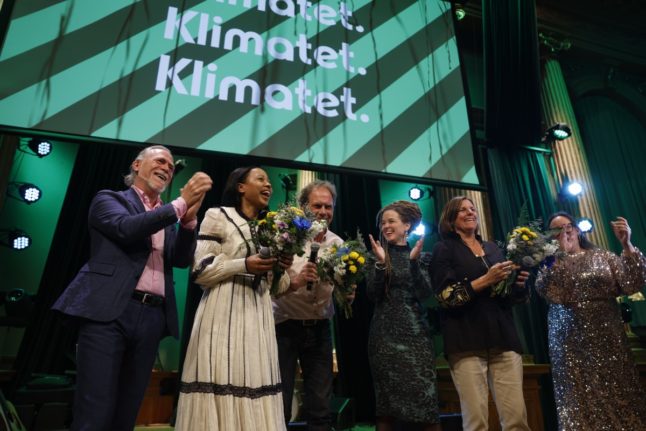1. A lot of Swedes do care about the climate
The post-ballot survey by Gothenburg University’s SOM Institute after the 2022 national election found that the Green Party had surpassed the Sweden Democrats as the party the most voters said they actively disliked.
This new “most hated party” moniker coupled with declining youth engagement in climate issues, and the sheer volume of climate-sceptic posts on X, has made it at times seem like Swedish voters no longer care much about climate change.
The success of the Green Party and the Left Party, both of whom made fighting climate change their main campaign issue, indicates that this is not the case.
According to preliminary figures, the Green Party saw its share of the vote leap up by 2.3 percentage points to 13.8 percent, while the Left Party saw theirs leap by 4.2 percentage points to 11 percent, winning the party a second seat in the European parliament.
There are other signs that the government’s decision to push Sweden way off the track to meet its 2030 and 2045 emissions goals by sharply reducing and then scrapping the biofuels obligation might be losing it support.
A survey for Indikator for the public broadcaster SR in the run-up to the election found that 57 percent of voters now believe the government is managing environment policy “quite badly or very badly”, compared to 33 percent who thought they were doing “quite well or very well”.
Admittedly, both parties usually do better in European elections than national elections, and both fielded heavyweight candidates.
But this is nonethelesss a sign that the Green Party’s new leaders, Amanda Lind and Daniel Helldén, could bring the party out of its long slump, and that the climate might be higher on the agenda in the run-up to the next national elections in 2026.
2. Great Replacement Theory doesn’t play so well with the broader electorate (and running troll farms probably isn’t great either)
The overriding political story in Europe in recent decades has been the success of far-right or radical-right parties like the Sweden Democrats.
While such parties have proved themselves more than capable of winning well over 20 percent, and sometimes closer to 30 percent, of the vote by promising to stop immigration and crack down on crime, doing so has generally involved sidelining their more extremist elements and softening their rhetoric.
So it probably wasn’t a great idea for Sweden Democrat leader Jimmie Åkesson to write an opinion piece in the run-up to the election seeking to legitimise the concept of folkutbyte, a clear reference to the Great Replacement Theory that underpinned the deadly terror attack mounted by the Norwegian extremist Anders Breivik.
The election campaign also featured videos of African migrants, adding a racial element the party has avoided since the bad old days of the early 1990s.
It may be that some potential supporters also baulked at the revelations from TV4’s Kalla Fakta that the party has been using fake social media accounts to influence them. Joakim Wallenstein, the party’s communications chief, was recorded boasting about how the party uses less extreme content to draw in potential voters in and then moves them slowly to more radical positions. “You don’t deal out heroin in the school playground, you start with cigarettes,” he said.
No one likes getting made to feel a mug.
3. There’s demand for an economically and socially liberal party in Sweden
None of the three smaller parties that risked coming under the four percent threshold to enter the EU parliament actually did so, and one – the Centre Party – was a full 3.3 percentage points over the threshold, at 7.3 percent.
That was worse than its performance in the 2019 EU election, but better than expected. Partly this is credit to the party’s previously little-known MEP Emma Wiesner, who turned out to be a passionate performer in election debates, but it also reflects support for the party’s economically and socially liberal position, in favour of lower taxes, open immigration, and climate action.
Arguably, the Liberal Party, which received 4.4 percent, also benefited from the demand for a proper liberal party, with one of its MEP candidates, Anna Maria Corazza Bildt, claiming (wrongly) in the campaign that her party had already decided to break off cooperation with the Sweden Democrats after the next national election.
Finally, the lead MEP candidate for the Christian Democrats, Alice Teodorescu Måwe, launched her campaign by describing herself as supporting liberal immigration in theory, but in favour of tighter migration policy in practice, due to Sweden’s failure to adequately integrate those who have arrived in the country in recent decades.
Maybe a sunnier, more optimistic politics would appeal to voters.
4. The Social Democrats can’t afford to be complacent
The Social Democrats increased their vote share in a European election for the first time since Sweden joined the EU in 1995, winning 24.8 percent of the vote, up 1.4 percentage points.
But they could have and should have done better. Heléne Fritzon and Johan Danielsson, the rather uninspiring candidates the party put forward, compared poorly with the heavyweights fielded by the Green and Left Parties, and also frequently struggled to articulate what the Social Democrats stood for in the European Union or what they wanted to do.
5. Startup parties need to have a clear political purpose
Swedish voters are more willing to take risks in EU elections, and have in the past voted three newly launched parties into the European Parliament: the Feminist Initiative, the Pirate Party, and Junilistan.
But Folklistan, the party launched by former Christian Democrat MEP Sara Skyttedal and the former Social Democrat MP Jan Emanuel, didn’t even manage to get close to the 4 percent needed to win an MEP. The “other” category in which they are included only amounted to 2.2 percent of the vote, suggesting they gained one percent, if that.
This failure came despite a series of attention-grabbing stunts which won the duo outsized coverage in the media.
The main difference between them and the three new parties that have managed to make it to Brussels (and Strasbourg) in the past, seems to be that the three others all stood for something – feminism, internet freedom, euroscepticism – while Folklistan seemed mainly an instrument for keeping Skyttedal in a job after being ousted from the Christian Democrats.



 Please whitelist us to continue reading.
Please whitelist us to continue reading.
Member comments